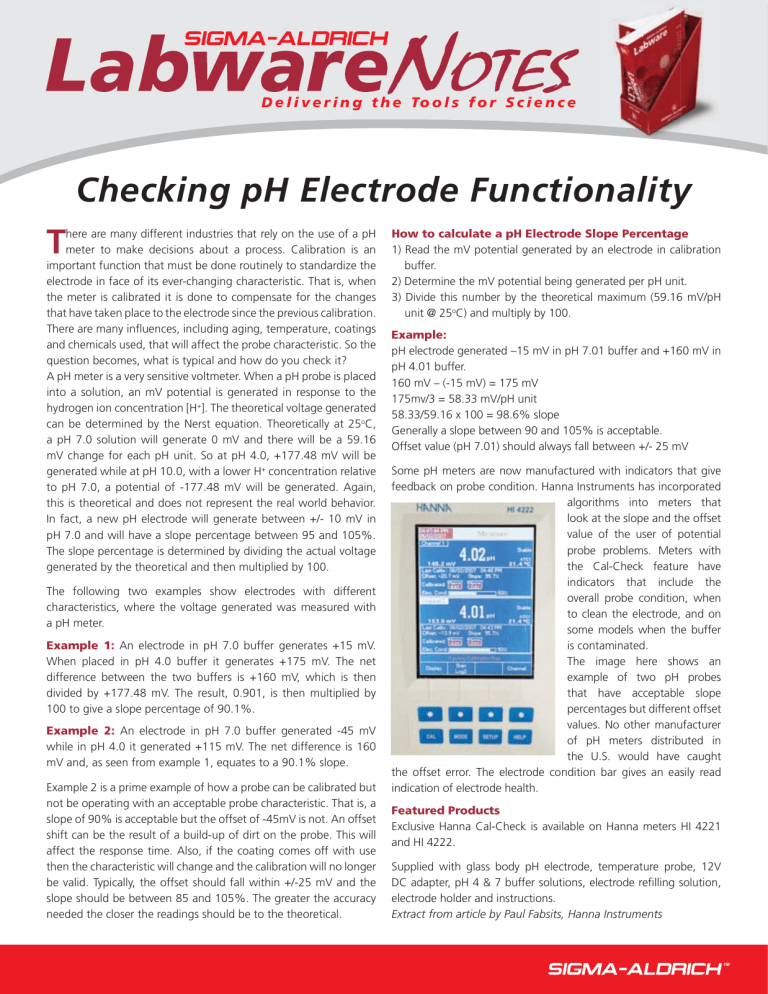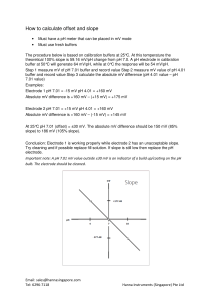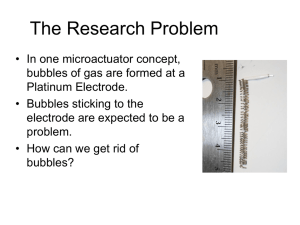
D e l i v e r i n g t h e To o l s f o r S c i e n c e Checking pH Electrode Functionality T here are many different industries that rely on the use of a pH meter to make decisions about a process. Calibration is an important function that must be done routinely to standardize the electrode in face of its ever-changing characteristic. That is, when the meter is calibrated it is done to compensate for the changes that have taken place to the electrode since the previous calibration. There are many influences, including aging, temperature, coatings and chemicals used, that will affect the probe characteristic. So the question becomes, what is typical and how do you check it? A pH meter is a very sensitive voltmeter. When a pH probe is placed into a solution, an mV potential is generated in response to the hydrogen ion concentration [H+]. The theoretical voltage generated can be determined by the Nerst equation. Theoretically at 25oC, a pH 7.0 solution will generate 0 mV and there will be a 59.16 mV change for each pH unit. So at pH 4.0, +177.48 mV will be generated while at pH 10.0, with a lower H+ concentration relative to pH 7.0, a potential of -177.48 mV will be generated. Again, this is theoretical and does not represent the real world behavior. In fact, a new pH electrode will generate between +/- 10 mV in pH 7.0 and will have a slope percentage between 95 and 105%. The slope percentage is determined by dividing the actual voltage generated by the theoretical and then multiplied by 100. The following two examples show electrodes with different characteristics, where the voltage generated was measured with a pH meter. Example 1: An electrode in pH 7.0 buffer generates +15 mV. When placed in pH 4.0 buffer it generates +175 mV. The net difference between the two buffers is +160 mV, which is then divided by +177.48 mV. The result, 0.901, is then multiplied by 100 to give a slope percentage of 90.1%. Example 2: An electrode in pH 7.0 buffer generated -45 mV while in pH 4.0 it generated +115 mV. The net difference is 160 mV and, as seen from example 1, equates to a 90.1% slope. Example 2 is a prime example of how a probe can be calibrated but not be operating with an acceptable probe characteristic. That is, a slope of 90% is acceptable but the offset of -45mV is not. An offset shift can be the result of a build-up of dirt on the probe. This will affect the response time. Also, if the coating comes off with use then the characteristic will change and the calibration will no longer be valid. Typically, the offset should fall within +/-25 mV and the slope should be between 85 and 105%. The greater the accuracy needed the closer the readings should be to the theoretical. How to calculate a pH Electrode Slope Percentage 1) Read the mV potential generated by an electrode in calibration buffer. 2) Determine the mV potential being generated per pH unit. 3) Divide this number by the theoretical maximum (59.16 mV/pH unit @ 25oC) and multiply by 100. Example: pH electrode generated –15 mV in pH 7.01 buffer and +160 mV in pH 4.01 buffer. 160 mV – (-15 mV) = 175 mV 175mv/3 = 58.33 mV/pH unit 58.33/59.16 x 100 = 98.6% slope Generally a slope between 90 and 105% is acceptable. Offset value (pH 7.01) should always fall between +/- 25 mV Some pH meters are now manufactured with indicators that give feedback on probe condition. Hanna Instruments has incorporated algorithms into meters that look at the slope and the offset value of the user of potential probe problems. Meters with the Cal-Check feature have indicators that include the overall probe condition, when to clean the electrode, and on some models when the buffer is contaminated. The image here shows an example of two pH probes that have acceptable slope percentages but different offset values. No other manufacturer of pH meters distributed in the U.S. would have caught the offset error. The electrode condition bar gives an easily read indication of electrode health. Featured Products Exclusive Hanna Cal-Check is available on Hanna meters HI 4221 and HI 4222. Supplied with glass body pH electrode, temperature probe, 12V DC adapter, pH 4 & 7 buffer solutions, electrode refilling solution, electrode holder and instructions. Extract from article by Paul Fabsits, Hanna Instruments Paula’s Pointers Background Reading Follow these tips to get the best from your electrode. This text provides the coverage and practice needed to build a solid foundation in the mathematical concepts used in laboratory sciences. The convenient workbook design includes practice problems that help users focus on areas they want to strengthen, such as solutions, dilutions, pH and graphing. Z700681 Essential Laboratory Mathematics 1. Use correct electrode storage solution to ensure minimum electrode response time. 2. Clean electrode to prevent drift and slow response times. Remember excessive cleaning may impair performance and shorten electrode life. 3. Remove the fill hole cover during calibration and measurement. Cover the fill hole overnight and during storage. 4. Filling solution level must be higher than the sample level. 5. Rinse to prevent contamination by carry-over on the electrodes. Do not wipe the pH electrode glass bulb, as static will result in slow or drifty response. 6. Stir all buffers and samples at a uniform rate. Prevent heat transfer by using a piece of insulating material between the stir plate and beaker. 7. Do not re-use buffers and standards and ensure they are within the expiration date before use. 8. Calibrate at least once a day with 2 or 3 buffers that bracket the expected sample range. For more details, visit our web site at sigma-aldrich.com/labwarenotes Latest News Buchi Evaporator Browser inding the right Buchi evaporator can be tricky. Finding the right parts and attachments can be even more difficult. Our Buchi browser features the newest Buchi Models, plus it organizes the replacement parts for previous and current versions in easy-to-navigate sections. The Evaporator Comparison Table has all of the products in one easy table to show all of the options from glass assemblies to vacuum controller options. Each of the sections in the browser provides representative pictures. Finally, there is a comprehensive Buchi Parts List, which organizes the products based on the Buchi part number. Go to sigma-aldrich.com/labwarenotes for more details. F Labware Listens he Sigma-Aldrich Technical Service teams are frequently asked to recommend pH electrode cleaning and storage solutions. However, we did not offer a simple solution within our product range. Recognizing this demand, we are now able to offer a full range of pH electrode cleaning and storage solutions. No matter what test samples you are using we have a cleaning solution for you. T Z655163 General purpose cleaning solution Z655171 Protein cleaning solution Z655198 Inorganic cleaning solution Z655201 Oil and fat cleaning solution Z655228 Storage solution 6 5 Electrode cleaning and storage solutions 7 4 7 7 5 2 9 8 3 3 1 3 1 6 7 1 6 5 5 3 4 5 2 4 6 9 Down Time Number puzzles first appeared in newspapers in the late 19th century in the form of magic squares that relied on arithmetic to solve. Soon after a Suduko like puzzle appeared. Unlike the Magic Square, Suduko is a logic based puzzle where the objective is to complete the grid so that each column, row and each 3x3 square contains the digits 1 to 9. The completed puzzles are a form of Latin square with the addition of no repetitions in the 3x3 square. Labware Links For more detailed information on the products featured in this newsletter along with back issues and many useful Labware Web links and protocols visit sigma-aldrich.com/labwarenotes. ©2007 Sigma-Aldrich Co. All rights reserved. SIGMA, , SAFC, , SIGMA-ALDRICH, ALDRICH, , FLUKA, , and SUPELCO, are trademarks belonging to Sigma-Aldrich Co. and its affiliate Sigma-Aldrich Biotechnology, L.P. Sigma brand products are sold through Sigma-Aldrich, Inc. Sigma-Aldrich, Inc. warrants that its products conform to the information contained in this and other Sigma-Aldrich publications. Purchaser must determine the suitability of the product(s) for their particular use. Additional terms and conditions may apply. Please see reverse side of the invoice or packing slip. JWH 03114-504402 0097 Printed on Recycled Paper — A Worldwide Operation with a Global Commitment




